The Camargue horse is an ancient breed native to the Camargue region of France. These horses are known for their hardiness, stamina, and spirited nature.
They are often used for tending Camargue bulls and riding and are also popular among beginners due to their docile nature.
The Camargue horse is one of the oldest breeds of horses in the world, with origins that remain relatively unknown.
They are known for their sturdy build, excellent endurance, and ability to live on scarce forage.
Their coat is typically gray, which is why they are sometimes referred to as white horses.
If you want to learn more about the Camargue horse breed, this article will provide a comprehensive profile of these majestic animals. From their physical characteristics to their history and uses, we’ll cover everything you need to know about this fascinating horse breed.
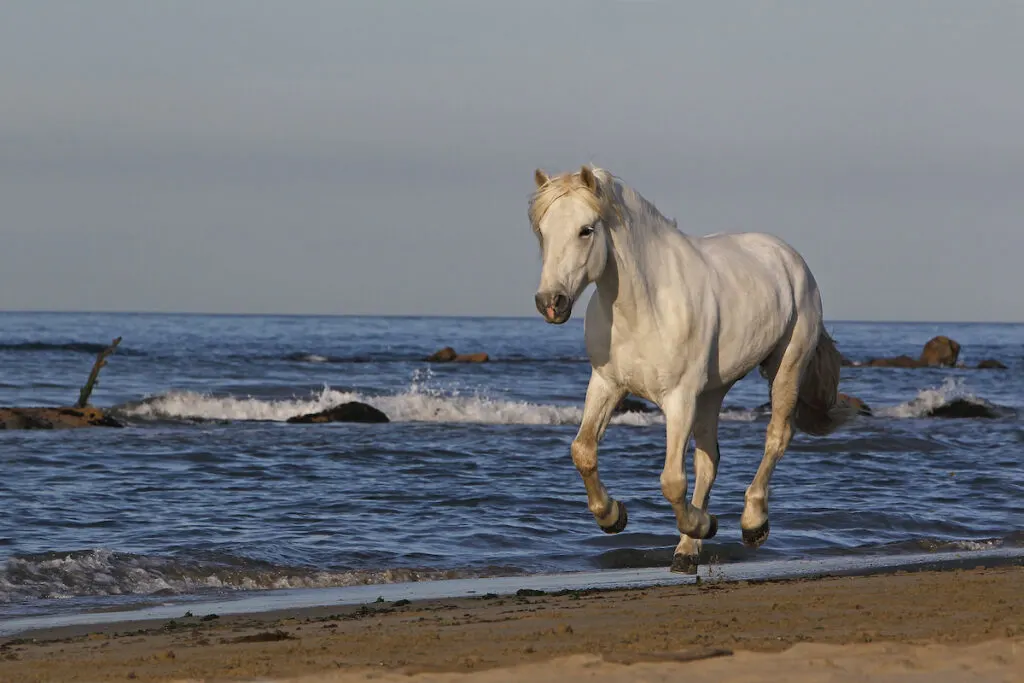
Table of Contents
History and Origin
Ancient Lineage
The Camargue horse breed has an ancient lineage that goes back thousands of years. Researchers claim that the breed descended from ancient Solutré horses, going back to the Upper Paleolithic period. In Burgundy, France, substantial evidence exists to support this.
The breed was adored by Celtic and Roman invaders conquering the Iberian Peninsula. As a result, their heredity is connected to Iberian steeds.
Regional Significance
The Camargue horse breed is native to the Camargue region of southern France. The horses are semi-wild and live in small herd groups. The breed is well adapted to the harsh environment of the Camargue region, with its marshy terrain and extreme temperatures.
Julius Caesar was one of the first to recognize the significance of the Camargue horses. He used the horses to transport his troops across the Rhone River during his campaign against the Gauls.
Later, Napoleon also recognized the breed’s value and used them for his cavalry. Today, the Camargue horse is a symbol of the Camargue region and is used in various cultural events and festivals.
The breed was brought to the United States in the 1800s and became a prominent breeding stock line there also.
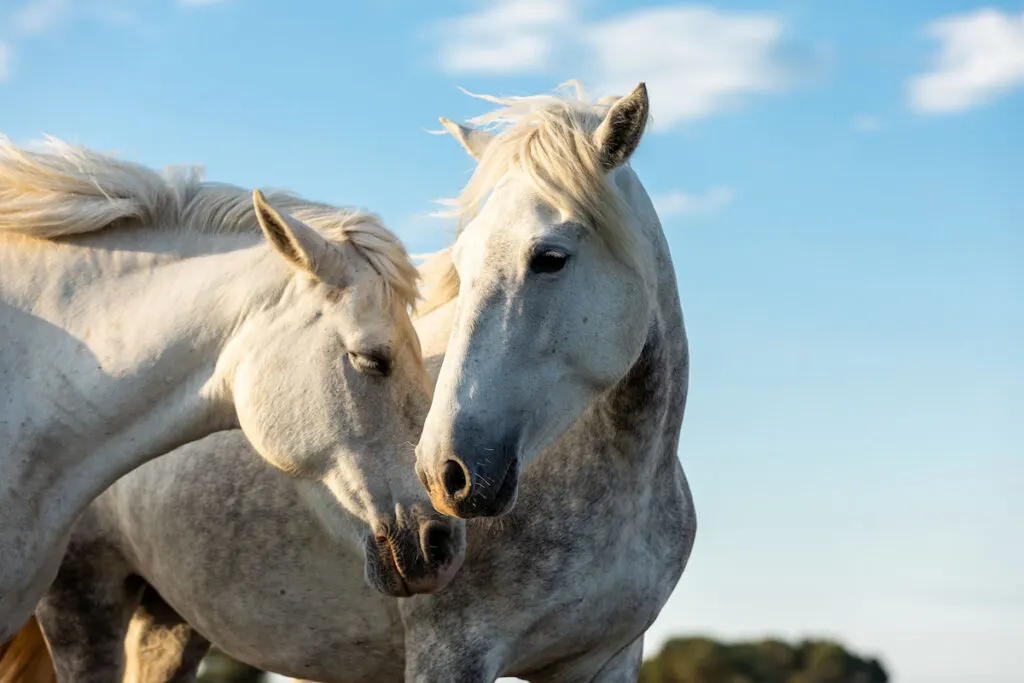
Physical Characteristics
The Camargue horse is a primitive breed that has been around for centuries. They have a distinct appearance and are known for their ruggedness and hardiness. In this section, we will take a closer look at the physical characteristics of the Camargue horse.
Color and Markings
Adult Camargue horses are always grey. Foals can be born in any color but are commonly bay or chestnut.
In order to be registered in the studbook, a horse MUST be grey.
Camargue horses will change from their darker foal color to a steel grey color, and eventually turn all white as they age.
They have short, thick manes and tails, which are often left untrimmed.
Size and Build
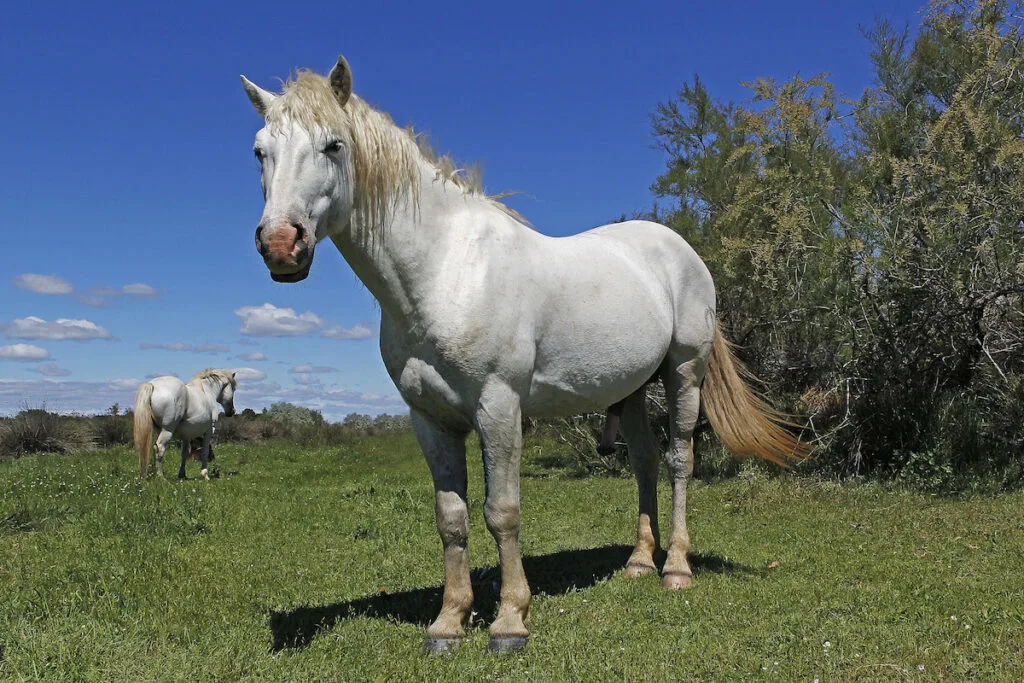
The Camargue horse is a medium-sized breed, standing between 4.4-5 feet (1.35 and 1.50 m) tall at the withers. They have a square head with a straight profile, which is another distinguishing feature of the breed.
These horses have strong, sturdy legs with unique feet. Their hooves can withstand significantly more moisture than other breeds, and they seldom have issues with their feet or require shoes.
The Camargue horse weighs between 660 and 880 lbs (300 and 400 kg). They are sturdy horses with excellent endurance and can live on scarce forage.
Behavior and Temperament
Social Structure
The Camargue horse is a social animal and lives in herds in the wild. They have a friendly temperament and are known to be quite gentle.
They are also intelligent and have a strong sense of loyalty to their herd. They can form strong bonds with their caretakers and other horses in captivity.
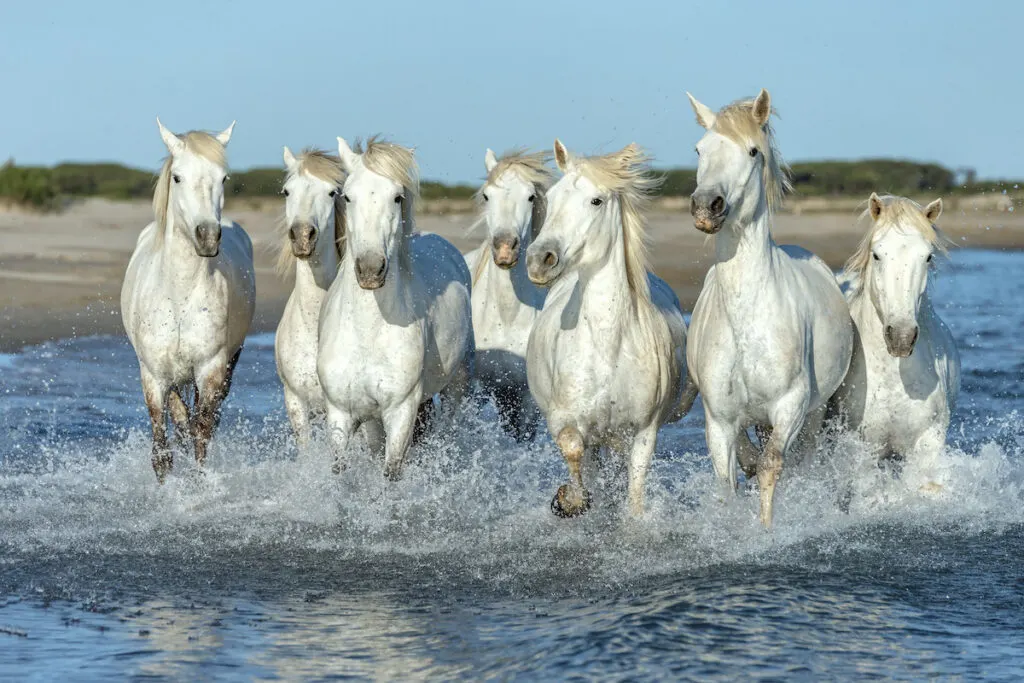
Trainability
The Camargue horse is known to be quite trainable due to its intelligence and willingness to please. They are often used for tending Camargue bulls and riding. They make excellent riding horses with incredible endurance.
The breed possesses natural hardiness and stamina and is otherwise tough and spirited. They have a somewhat heavy head and squarish muzzle, which points to their shared ancestry with the Barb. The neck is short with a thick mane. They have a lively, intelligent, and level-headed character.
Habitat and Lifestyle
Life in the Wetlands
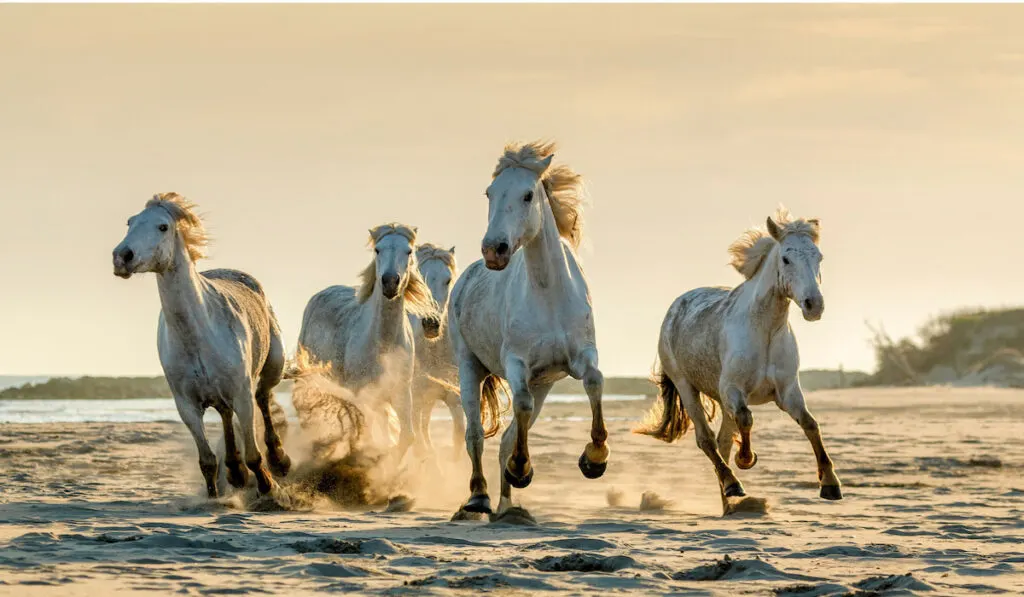
The Camargue horse is a semi-feral breed that is native to the Camargue region of Southern France, which includes the marshes and wetlands of the Rhône delta near the Mediterranean Sea. These wetlands are a unique ecosystem of saltwater and freshwater species. The Camargue horse has adapted to this environment by developing a robust immune system that can withstand the harsh conditions of the marshes.
Camargue horses can live in the wild for extended periods. Their stamina and natural hardiness make them well-suited for life in the wetlands. They can graze on the sparse vegetation in the marshes and drink the available brackish water.
Human Interaction
The Camargue horse has a long history of living alongside humans. They have been used by the Gardians, the traditional cowboys of the Camargue area, for centuries. The Gardians use these horses to herd the black bulls that are raised in the region for bullfighting.
The Camargue horse is also used in the manade, a traditional form of bullfighting unique to the Camargue region. In the manade, Camargues are used to control the bulls and protect the riders.
Despite their long history of living alongside humans, the Camargue horse remains semi-feral. They are allowed to roam freely in the wetlands and are only rounded up periodically for veterinary care and other necessary interventions.
Conservation and Breeding
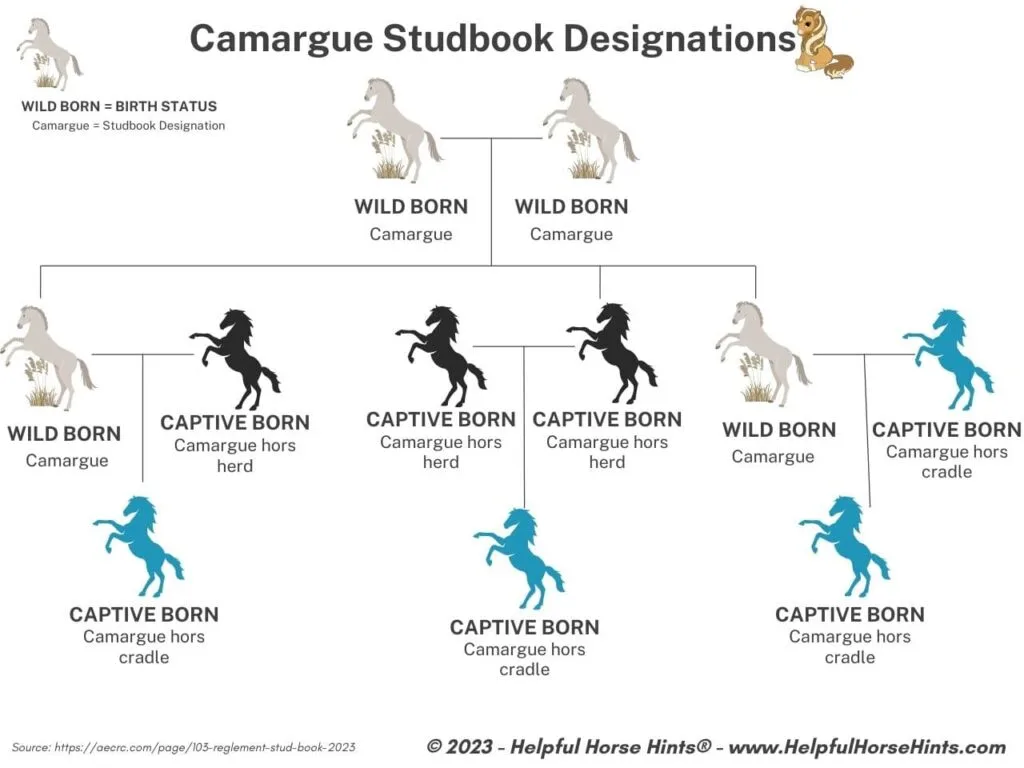
Types / Classifications of Camargue Horses
Within the breed are three different designations:
Camargue – this designation is limited to horses born and bred in the wild. The wild foals receive a hot brand before weaning to designate their status.
Camargue hors herd – this designation is for horses for whom both parents were bred and born in the wild, but they themselves were not.
Camargue hors cradle – this designation is for horses for whom both parents are registered in the studbook, but they don’t otherwise qualify for one of the above designations. While still “pure” Camargue horses, they are further removed from the wild population.
Breed Preservation Efforts
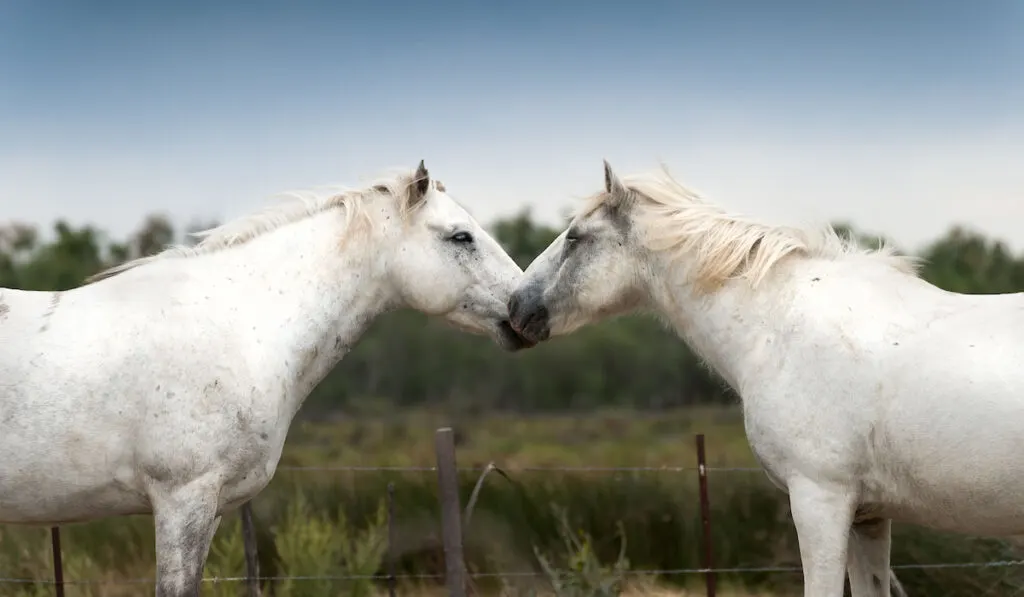
The French government has taken significant steps to preserve the Camargue breed. To ensure the breed maintains its unique characteristics, the government created pure breed measures and established a studbook in 1978.
The studbook is used to register breeders and ensure that they follow strict breeding standards. These measures have been instrumental in preserving the breed’s genetic diversity and maintaining its distinct characteristics.
In addition to the government’s efforts, the Camargue National Park plays a vital role in preserving the breed. The park is home to several wild herds of Camargue horses, which are protected by law. The park’s management team works closely with breeders to ensure that the wild herds remain healthy and genetically diverse.
The Camargue Horse Today
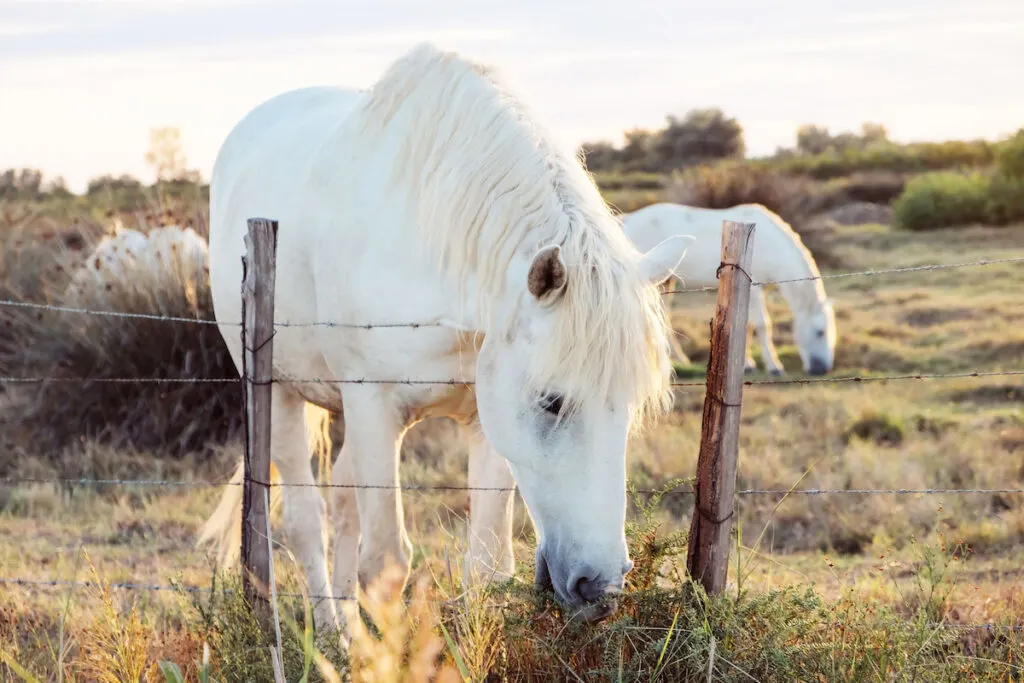
Today, the Camargue horse is a popular breed used for various purposes, including riding, racing, and working on farms. The breed’s unique characteristics, such as its hardiness and resistance to disease, make it an excellent choice for people looking for a low-maintenance horse.
Breeding Camargue horses is a time-consuming and expensive process.
Breeders must follow strict standards to ensure that the horses maintain their unique characteristics.
They must also work closely with the government to ensure their breeding practices align with the breed’s conservation efforts.
Despite the challenges, breeders are committed to preserving the Camargue breed. Their efforts have been successful, and the breed continues to thrive today.
Frequently Asked Questions
What is the typical height of a Camargue horse?
The Camargue horse is a small breed with an average height of 13.3 to 14.3 hands, or around 135 to 145 cm. They are known for their sturdy build and muscular physique.
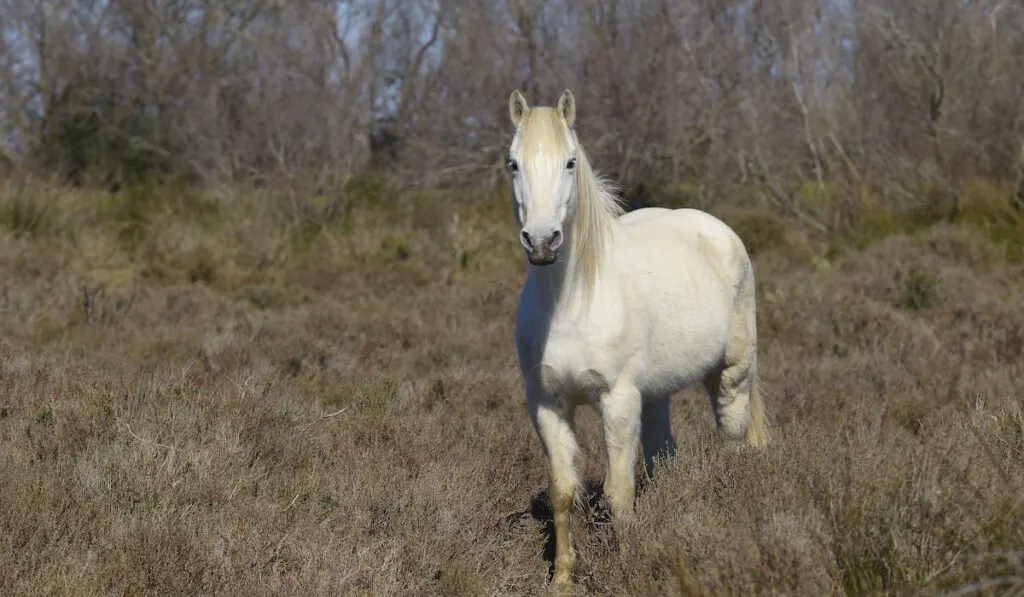
Where can one see Camargue horses in their natural habitat?
Camargue horses are native to the Camargue region of southern France, where they roam freely in the wetlands and marshes. Visitors can see these horses in their natural habitat, particularly in the Parc Naturel Régional de Camargue.
Are Camargue horses considered wild, or are they domesticated?
The Camargue horse is a semi-feral breed, meaning they are not wholly wild but not fully domesticated. These horses have lived in the Camargue region for centuries and have adapted to their environment, but they are still managed and cared for by humans.
How do you properly pronounce ‘Camargue’ when referring to the horse breed?
The correct pronunciation of ‘Camargue’ is ‘ka-marg’.
Is the Camargue breed classified as a horse or a pony?
Camargues are classified as horses, not ponies. Despite their small size, they are still considered a horse breed due to their conformation and characteristics.
Is it possible to purchase a Camargue horse, and if so, where?
It is possible to purchase a Camargue horse, but they are relatively rare outside their native region. Interested buyers can contact breeders in France or search for Camargue horses for sale online. However, note that these horses require specialized care and training, so buyers should do their research before making a purchase.
Resources:
- https://breeds.okstate.edu/horses/camargue-horses.html
- https://aecrc.com/
- https://aecrc.com/page/103-reglement-stud-book-2023

